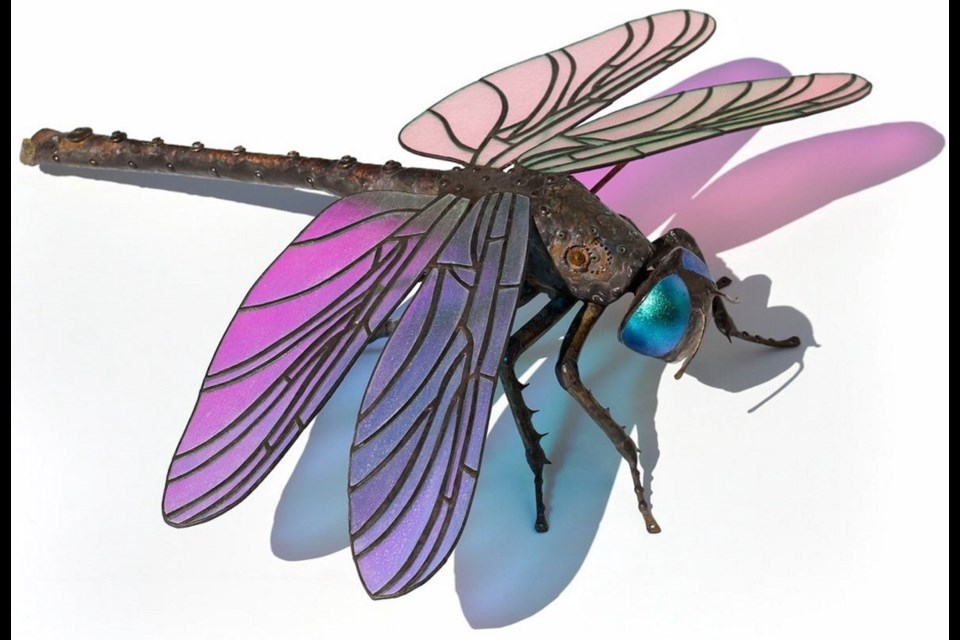 Anita Rydygier is a graduate of the Royal College of Art in London and worked as a textile designer, creating printed textile collections sold around the world. Coming to Victoria in 2001, she opened her own store and gallery, WestCoast Eco Home, in Fan Tan Alley. Throughout it all, privately and patiently, she has been making small paintings.
Anita Rydygier is a graduate of the Royal College of Art in London and worked as a textile designer, creating printed textile collections sold around the world. Coming to Victoria in 2001, she opened her own store and gallery, WestCoast Eco Home, in Fan Tan Alley. Throughout it all, privately and patiently, she has been making small paintings.
The paintings are a personal exploration.
“I do it for myself,” Rydygier told me. How else to justify the months she gives to each? Apparently abstract, they stem from her exploration of “the big questions.” What is life? Why are we here? How did we get here? Where are we going?
Her paintings are a bit like maps, and some are based on drawings by her nieces and nephews, youngsters whose vision is without restriction or convention. With painstaking technique, she gets right inside the pre-adult world and has discovered an inner space of universal connectedness.
Because her artworks have clean edges and a smooth surface, people often assume they are computer-generated or printed, but that’s never the case. With a pencil, she draws her design on tracing paper, and transfers it onto a smooth-surface board. Overlaying the board with frisket, a semi-adhesive sheet of plastic, she uses a scalpel to cut out parts of the image she wants to expose to paint.
Then, with an airbrush, she colours these spaces with ink. Sometimes she uses a brush and gouache, an opaque watercolour. The resulting image, which admittedly takes its own course, is slowly built up. In the end, the artist outlines and stitches it together with a free-flowing line from a Pilot pen, making a delicate pathway for the mind to explore.
Is this story-telling, or non-objective decoration? Neither, really.
“I just try to make something that you want you to look at,” Rydygier told me, “like a flower. You get a nice feeling. You don’t have to understand the meaning it has for me. But if it resonates intuitively with you, and you connect to it, then it makes you want to continue looking.”
To continue looking ... isn’t that what art is all about?
Anita Rydygier at Dales Gallery, 537 Fisgard St., dalesgallery.ca, until Feb. 24.
Since discovering seangoddardinsects.com recently at Art Rental and Sales of the Art Gallery of Greater Victoria, I can tell you that Sean Goddard really has them climbing the walls. While he was working as a stained-glass artisan in Tofino, a friend gave him a book called An Inordinate Fondness for Beetles. When he saw the “exploded” diagrams of bugs, he was hooked. Goddard’s skill set — cutting and forming glass, bending and soldering copper — was all he needed.
After Goddard moved to Saltspring Island, his bugs really took off. He sells all he can make at the weekly summer market there and now that his Victoria show’s over, he’s off to Seattle. But he will soon be back at his Saltspring home-gallery.
When I phoned Goddard, he asked for permission to continue hammering as we spoke. Working with sheet copper, copper tubing and heavy-gauge wire, he forms many pairs of elegant legs. Thorns and spikes are created by pulling out solder to a point. For the wings and exoskeleton, he uses dichroic glass, which carries a dazzling array of spectral colours not unlike the wings of a butterfly or the carapace of a beetle. Seems fitting.
Though not an entomologist, Goddard has learned a lot about bugs. The biggest of his works, half a metre across, are realistic enough to scare those with an aversion to insects. At this scale, beetles look more like a suit of samurai armour than something you’d squash with a fly swatter.
I am impressed by his concept, his craftsmanship and the shock value of seeing one of these babies climbing the walls.
Kate Celis, an artist I have admired for 35 years, has died. Celis was a native of Paisley, Scotland, and attended the Glasgow School of Art. There she met James Lindsay and they had three children — Anna, Katherine and James.
She was a woman of high intelligence, sharp wit and sure skill with her pastels. And in every aspect of her life she faced challenges that precluded the full flowering of her talent.
Upon escaping the patriarchy of Scotland in 1970, Celis made a loving home for her family in Victoria, in so far as it was possible within the means of her artist husband. The onset of lupus 40 years ago, and with it a debilitating epilepsy, made her daily life a trial. She eventually required dialysis three days a week. Their son James, known as Jamer, became a talented tattoo artist with a shop on Government Street, but he succumbed to a drug overdose three years ago.
After Jamer died, Celis joked that she’d live as long as her house cat needed her. The cat died a year ago, yet Celis continued, living on her own, and cherishing the independence left to her.
A friend wrote: “She was smart, funny, elegant, brave and fiercely political. An artist’s artist.”
Kate Celis died at home at age 69 on Jan. 24.
